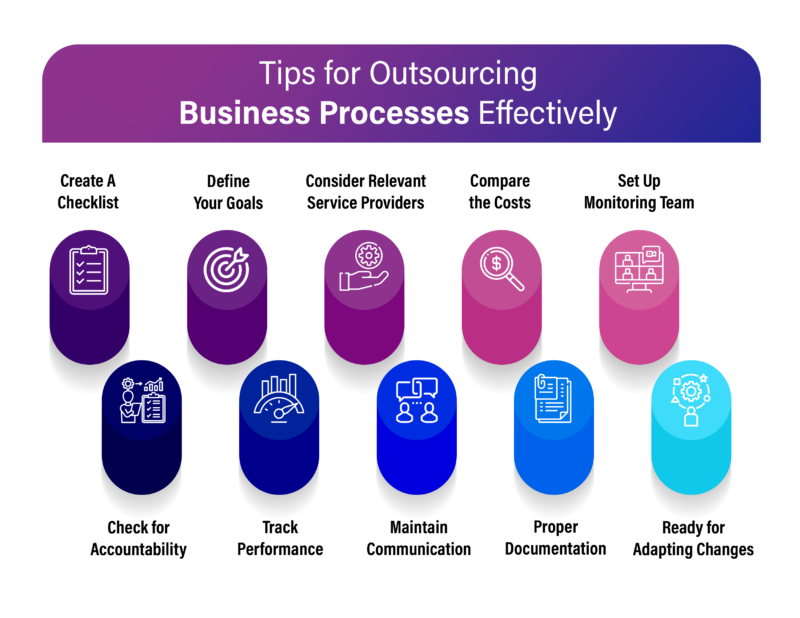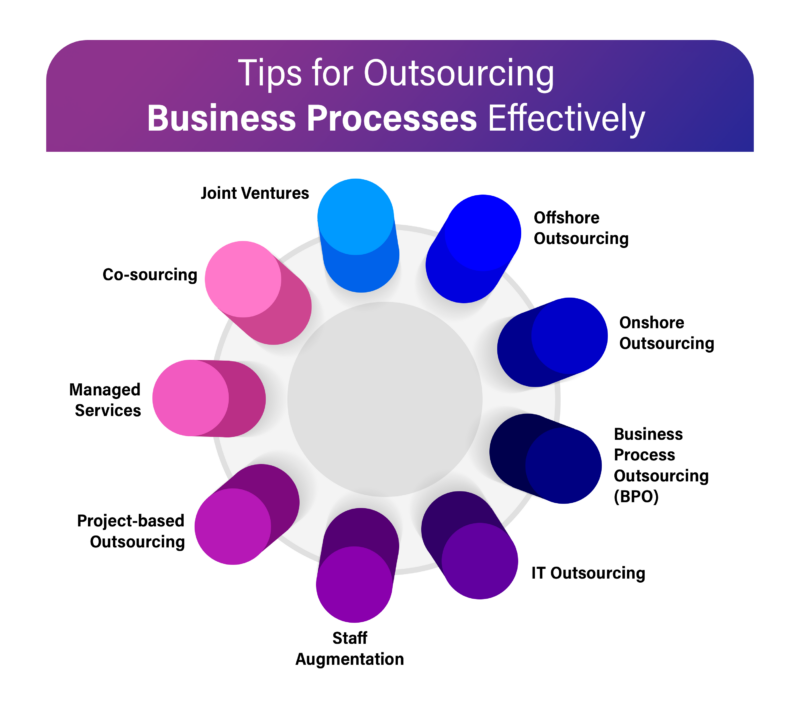Outsourcing can play a pivotal role in shaping a company’s growth strategy. According to Deloitte’s Global Outsourcing Survey 2020, 78% of companies surveyed felt positive about their relationship with their outsourcing providers, while the global outsourcing market reached a staggering $92.5 billion in 2019. While these figures illustrate the significance of outsourcing, it’s critical to note that the process has challenges.

To harness the benefits of outsourcing and avoid common pitfalls, this article offers ten high-yield tips to guide your businesses in outsourcing strategies.
1. Clearly Define Your Goals
Before you begin your expedition into the outsourcing world, it’s paramount to bring your objectives into sharp focus. The Global Outsourcing Survey carried out by KPMG in 2020 provides crucial insight into this, revealing that a significant 52% of firms pin strategic objectives as the driving force behind their choice to outsource.
The spectrum of these strategic objectives is wide and varied. Cost savings, for instance, emerge as a central goal for many organizations. Outsourcing can be a powerful lever to reduce operational expenses, enabling the company to reallocate resources to more strategic initiatives. With their specific expertise and efficiencies, your outsourcing partner can offer services at a more cost-effective rate than what may be possible in-house.
The opportunity to access industry-specific expertise also frequently surfaces as a key objective. The right outsourcing partner can infuse valuable skills and knowledge into your operations, potentially filling in the gaps in your internal teams’ capabilities. By leveraging the experience and know-how of a specialized service provider, you can fast-track the execution of your business functions with better precision and quality.

Another fundamental objective that guides the outsourcing journey is the ambition to enhance service quality. A competent outsourcing partner, armed with the right tools, technologies, and talent, can elevate the standard of your services, often surpassing what could be achieved internally. This can help foster customer satisfaction and loyalty, further propelling your market position.
In addition, accelerating business processes is an important strategic goal for many firms. By entrusting certain business functions to a service provider, your internal teams can focus on core competencies, facilitating faster and more efficient workflows. This could lead to improved productivity and operational agility.
Clearly, delineated goals act as an essential compass on your outsourcing journey. They guide the selection of the right outsourcing partner, dictate the terms of engagement, and establish clear performance benchmarks. Such clarity is the foundation of successful outsourcing – ensuring that the decisions align seamlessly with your broader business strategy.
2. Select the Right Vendor
Selecting the appropriate outsourcing provider is of utmost importance. Findings from Deloitte’s survey underline this, revealing that a substantial 84% of business executives asserted that their outsourcing partners not only fulfilled but often surpassed their anticipated expectations [1]. This suggests that there is a potent correlation between the process of selecting an outsourcing provider and the subsequent success of the outsourcing initiative.
There are several key factors to take into consideration during the process of selecting an outsourcing provider. To begin with, the provider’s experience within your specific industry can significantly impact how effectively they can integrate into your business operations. A provider well-versed in your industry would understand the unique challenges and opportunities it presents, which can significantly enhance the quality and efficiency of the outsourced services.
Technical expertise is another critical criterion. The complexity of business processes often requires a high level of technical proficiency for effective execution. Therefore, the technical capabilities of an outsourcing provider can play a pivotal role in ensuring that your outsourced business processes are handled with the necessary finesse and knowledge.
Quality of resources, both in terms of human talent and technological infrastructure, is another key consideration. An outsourcing provider that invests in high-quality resources can significantly elevate the effectiveness of your business strategy. The quality of these resources will invariably influence the delivery, efficiency, and overall success of the outsourced tasks.
The cultural fit between your organization and the outsourcing provider is another aspect that shouldn’t be overlooked. A provider that aligns well with your company’s values, work ethic, and culture can seamlessly blend into your operations, ensuring smoother communication and collaboration.
3. Establish Robust Communication Channels
Effective communication is a key determinant of most outsourcing success (or outsourcing model). Therefore, constructing a well-thought-out communication plan is a decisive factor in realizing the potential of your outsourcing goals. Such a plan should encompass several crucial elements that foster open, clear, and consistent communication with your offshore team.
First and foremost, the plan should detail the tools that will be utilized to facilitate communication. This could include a range of channels, from emails and video conferencing tools to project management software and collaboration platforms. Selecting the right tools that offer ease of use, reliability, and compatibility with your offshore team and in-house employees’ technical infrastructure is key to ensuring uninterrupted communication.
Next, the frequency of communication must be defined. Depending on the complexity and nature of the outsourced tasks, this could vary from daily updates to weekly meetings or monthly reviews. Determining the optimal frequency ensures a regular flow of information, allowing you to stay updated on progress, address issues promptly, and make timely decisions.
The content of the communication is another important component. It’s essential to establish what type of information will be communicated, such as project updates, performance metrics, challenges encountered, or any changes to be implemented. Clearly defining the content ensures that all parties comprehensively understand what is expected in each communication, reducing ambiguity and confusion.
Lastly, the responsibility for communication should be outlined. This involves determining who from your in-house and offshore teams will be responsible for maintaining communication and ensuring accountability and consistency. This guarantees that communication tasks are not neglected and ensures that information flows between the right people, preventing potential miscommunication or information gaps.
4. Focus on Quality, Not Just Cost
Outsourcing is commonly associated with the significant potential for cost savings. However, it’s important not to overlook quality’s role in the overall value that outsourcing can bring. An overly narrow concentration on cost reductions could result in short-term savings, but it might also pave the way for compromised quality, which could, in turn, impede long-term success. If quality is allowed to deteriorate in the quest for immediate cost savings, it can lead to customer dissatisfaction and damage to the business’s reputation, which are costly in their own right.
Including cost and quality considerations in your business plan becomes paramount in this context. This balanced approach ensures that the outsourcing plans align with the broader objectives of sustainable business growth and maintaining a competitive edge.
When shaping your outsourcing plans, it is vital to stress the importance of quality at every stage of the negotiation process. From the start, prospective outsourcing partners should know that quality cannot be compromised for cost savings.
This balanced approach might mean choosing a higher-cost provider because they are committed to maintaining high-quality standards. It might also translate into the decision to negotiate ownership of certain processes to maintain control over quality while outsourcing other functions that are less sensitive to quality fluctuations.
Remember to balance the scales between cost and quality when devising your outsourcing plans. This approach will ensure you gain short-term benefits and a long-term strategic advantage contributing to your overall business growth and success.
5. Retain Strategic Control
The process of outsourcing should never be mistaken as a step towards relinquishing control over your business operations. While outsourcing indeed involves delegating certain tasks or functions to a third-party provider, it does not signify abandoning control or oversight.
A key component of maintaining control is preserving ownership of your organization’s core competencies. These unique capabilities and skills give your business a competitive edge, and they should remain under your control and direction. Outsourcing frees up your in-house resources to focus more on these core competencies while your outsourcing partner efficiently handles non-core tasks.
Performance monitoring forms another crucial part of maintaining control. Even though specific operations might be outsourced, it’s essential to regularly review and assess the performance metrics tied to these functions. Doing so lets you keep a pulse on the progress and quality of the outsourced tasks, ensuring they align with your expectations and standards. You may need to establish key performance indicators (KPIs) and set up regular reporting structures with your outsourcing partner to track their performance effectively.
Ensuring strategic control in this way serves a dual purpose:
- Firstly, it prevents an over-reliance on vendors. While your outsourcing partner brings their own set of skills and resources, it’s critical for your organization to maintain a level of independence. This safeguards your business from potential issues like service disruption or differences in business goals that may arise with the outsourcing partner.
- Secondly, strategic control safeguards your company’s interests. By staying actively involved and keeping a firm grip on decision-making, you can ensure that the outsourcing arrangement aligns with your broader business objectives and does not compromise your company’s core values or standards.
6. Invest in Relationship Management
Successful outsourcing is heavily reliant on a solid commitment to relationship management. The nature of an outsourcing engagement goes beyond a simple transactional relationship. It is, in essence, a strategic partnership between your organization and your outsourcing provider. Investing in nurturing this relationship can significantly enhance the effectiveness of the outsourcing engagement, ultimately contributing to the overall success of the endeavor. Evidence of this can be found in a study by Gartner, which indicated that organizations with robust vendor management programs experienced a considerable reduction – 60% fewer – in vendor-related incidents.
The key to this process is regular vendor engagement. This involves maintaining consistent communication, ensuring that both parties are on the same page and that any potential issues are addressed promptly. Similarly, conducting regular performance evaluations is another critical aspect of relationship management. By systematically assessing your vendor’s performance, you can highlight areas of success and identify potential areas for improvement, helping maintain high-quality service delivery. Lastly, fostering a culture of collaborative problem-solving is vital. By working together to address challenges and devise solutions, you can strengthen your relationship with your vendor and ensure the outsourcing partnership is more productive and efficient.
7. Ensure Adequate Resource Allocation
Engaging in outsourcing, particularly in the initial stages, necessitates the allocation of considerable resources. This commitment is not solely financial but extends to encompass time, manpower, and strategic attention as well. These resources are fundamental in laying a strong foundation for the outsourcing relationship and ensuring its subsequent success.
Several activities that occur in the early phases of outsourcing require a significant input of resources. For instance, the process of vendor selection involves extensive research, discussions, and evaluations. This can be a time-consuming and labor-intensive task, given the importance of choosing a provider that aligns with your business’s needs and goals.
Similarly, contract negotiation is another resource-intensive activity. This stage demands a keen eye for detail and a deep understanding of the business requirements to ensure that the terms and conditions of the agreement protect your interests and foster a mutually beneficial relationship.
8. Adopt a Long-term Perspective
Outsourcing is a long-term commitment that often involves upfront costs and time investments. According to Everest Group, the average outsourcing contract length in IT and Business Process Outsourcing is 4.8 years. Therefore, adopting a long-term perspective is essential, focusing on the cumulative benefits of the outsourcing arrangement rather than immediate gains.
9. Plan for Risks and Contingencies
Like any business venture, outsourcing comes with risks. Deloitte’s survey found that 35% of companies had experienced an outsourcing service disruption, primarily due to cyber threats. Therefore, it’s critical to have robust risk management plans and contingency strategies. These might include comprehensive data security measures, backup plans, and disaster recovery protocols.
10. Regularly Review and Adjust Your Strategy
Finally, the dynamic nature of business necessitates regular reviews of your outsourcing strategy. Regular reviews allow for necessary adjustments based on changing business needs, performance outcomes, and evolving market dynamics.
Outsourcing can be a powerful tool for companies leveraging external expertise, achieving cost efficiencies, and focusing on their core competencies. However, effective outsourcing requires careful planning, robust management, and a strategic approach. By adhering to these ten high-yield tips, c-suite executives can ensure their outsourcing initiatives deliver maximum value and align with their broader business objectives.



Leave A Comment
You must be logged in to post a comment.